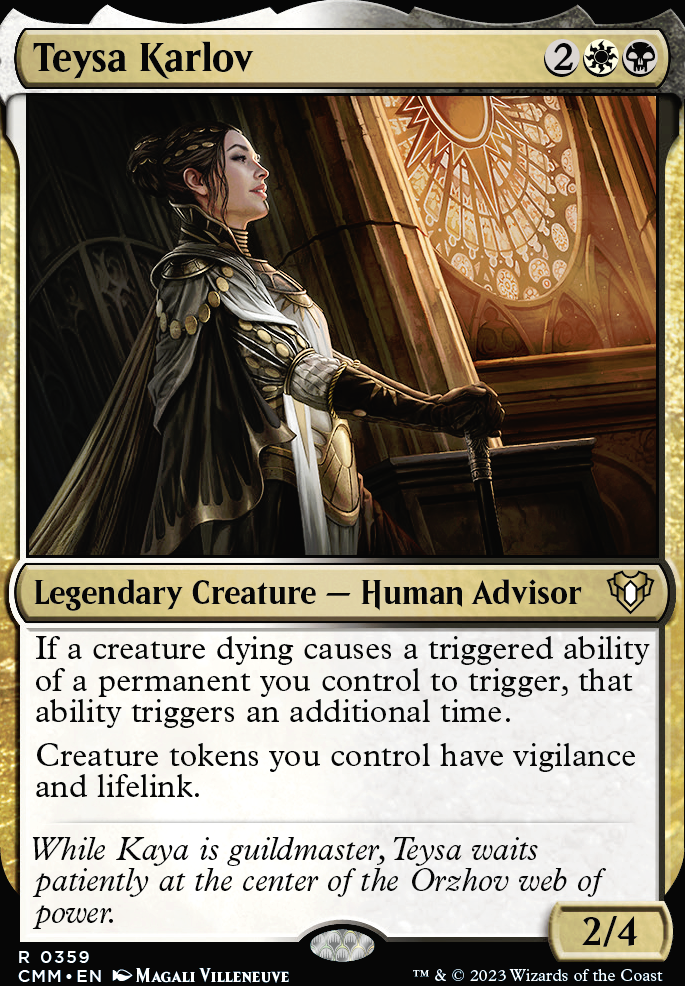Creature (34)
- 1x Adeline, Resplendent Cathar
- 1x Archangel of Thune
- 1x Athreos, God of Passage
- 1x Ayli, Eternal Pilgrim
- 1x Blood Artist
- 1x Celestine, the Living Saint
- 1x Corpse Knight
- 1x Drivnod, Carnage Dominus
- 1x Elas il-Kor, Sadistic Pilgrim
- 1x Elenda, the Dusk Rose
- 1x Esper Sentinel
- 1x Grim Haruspex
- 1x Hallowed Spiritkeeper
- 1x Hell's Caretaker
- 1x Hunted Witness
- 1x Imperious Oligarch
- 1x Kambal, Profiteering Mayor
- 1x Liesa, Forgotten Archangel
- 1x Luminous Broodmoth
- 1x Massacre Wurm
- 1x Midnight Reaper
- 1x Mirkwood Bats
- 1x Mondrak, Glory Dominus
- 1x Ophiomancer
- 1x Pitiless Plunderer
- 1x Priest of Forgotten Gods
- 1x Requiem Angel
- 1x Royal Assassin
- 1x Skirsdag High Priest
- 1x Sun Titan
- 1x Syr Konrad, the Grim
- 1x Teysa, Opulent Oligarch
- 1x Thalisse, Reverent Medium
- 1x Zulaport Cutthroat
Land (36)
- 1x Ancient Tomb
- 1x Arid Mesa
- 1x Bloodstained Mire
- 1x Cabal Coffers
- 1x Caves of Koilos
- 1x Command Tower
- 1x Fetid Heath
- 1x Flooded Strand
-
1x
Godless Shrine

- 1x High Market
- 1x Isolated Chapel
- 1x Mana Confluence
- 1x Marsh Flats
- 1x Nykthos, Shrine to Nyx
- 7x Plains
- 1x Polluted Delta
-
1x
Reflecting Pool

- 1x Reliquary Tower
- 6x Swamp
- 1x Temple of Silence
- 1x Urborg, Tomb of Yawgmoth
- 1x Vault of the Archangel
- 1x Verdant Catacombs
- 1x Westvale Abbey Flip
- 1x Windswept Heath
Artifact (7)
Commander (1)
Enchantment (10)
- 1x Anointed Procession
-
1x
Attrition

- 1x Cathars' Crusade
- 1x Dark Prophecy
- 1x Grave Betrayal
- 1x Grave Pact
- 1x Land Tax
- 1x Phyrexian Arena
- 1x Phyrexian Reclamation
- 1x Smothering Tithe
Instant (9)
- 1x Anguished Unmaking
-
1x
Dark Ritual

- 1x Enlightened Tutor
- 1x Fracture
- 1x Heliod's Intervention
- 1x Path to Exile
- 1x Vampiric Tutor
- 1x Vanishing Verse
Sorcery (3)
Suggestions
Updates Add
Comments
Attention! Complete Comment Tutorial! This annoying message will go away once you do!
Important! Formatting tips — Comment Tutorial — markdown syntax
Please login to comment
Casual
93% Competitive
| Date added | 1 month |
| Last updated | 5 days |
| Legality | This deck is Commander / EDH legal. |
| Rarity (main - side) | 16 - 0 Mythic Rares 46 - 0 Rares 18 - 0 Uncommons 6 - 0 Commons |
| Cards | 100 |
| Avg. CMC | 2.97 |
| Tokens | Clue, Copy Clone, Demon 5/5 B, Human 1/1 W, Human Cleric 1/1 BW, Morph 2/2 C, Snake 1/1 B, Soldier 1/1 W w/ Lifelink, Spirit 1/1 W, Spirit 1/1 WB, Treasure, Vampire 1/1 W |
| Votes | |
| Ignored suggestions | |
| Shared with | |
| Views |

